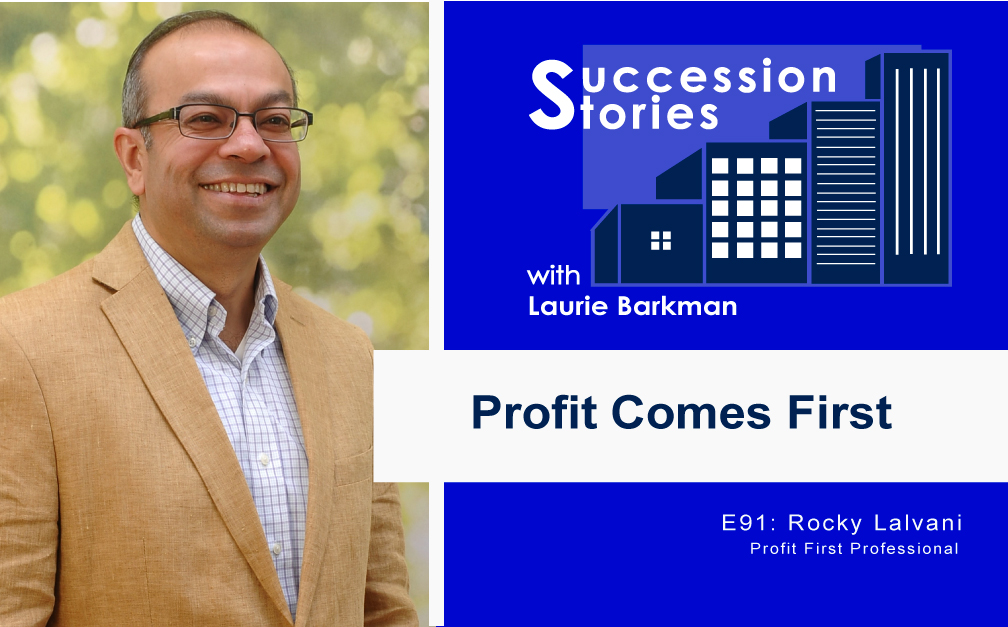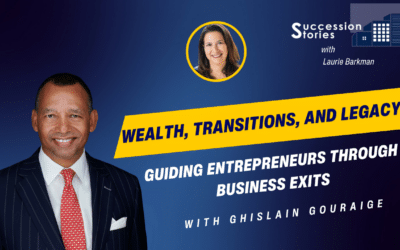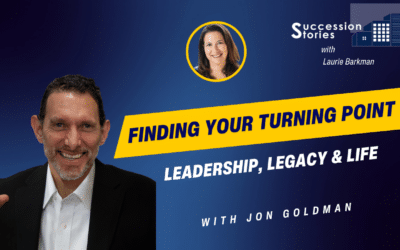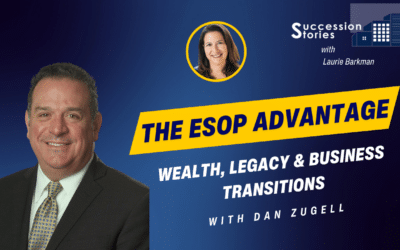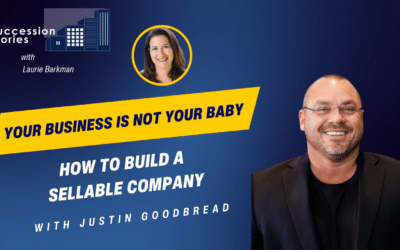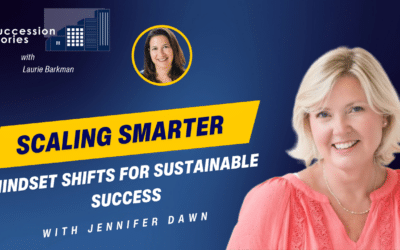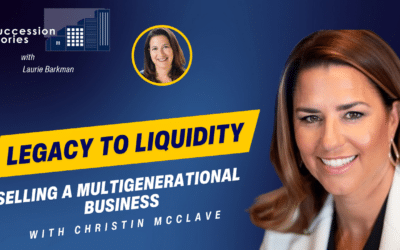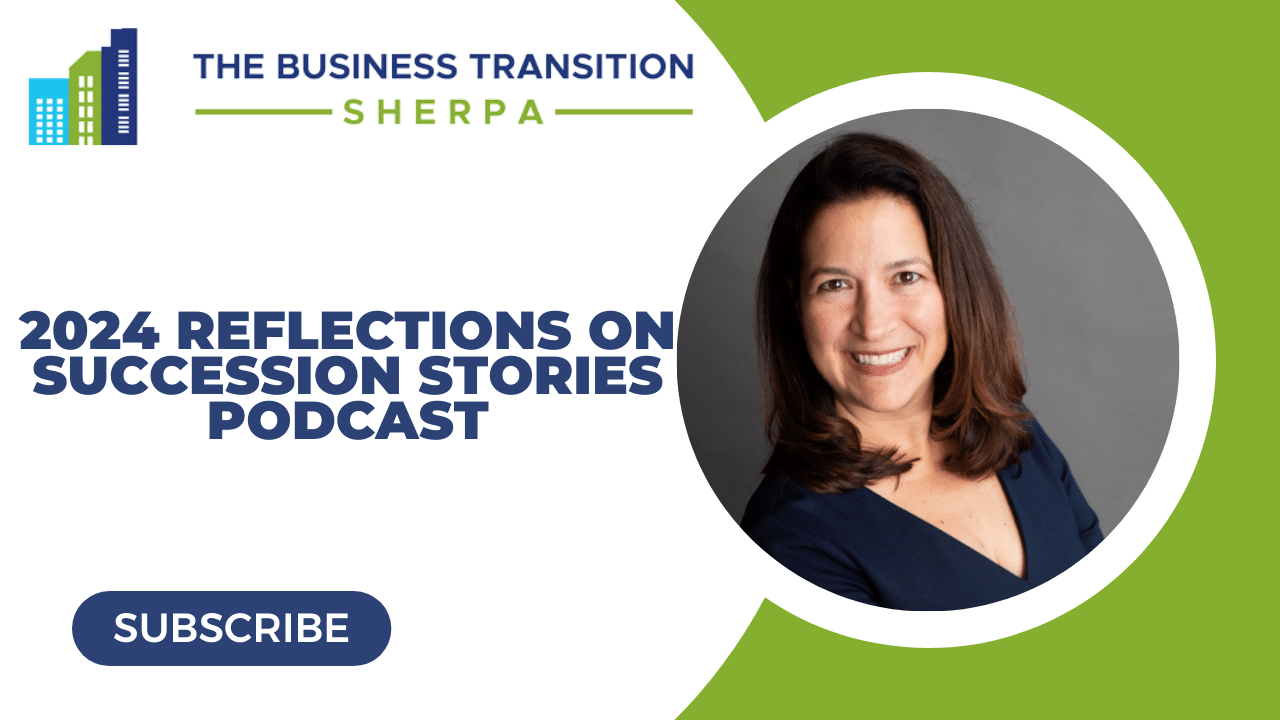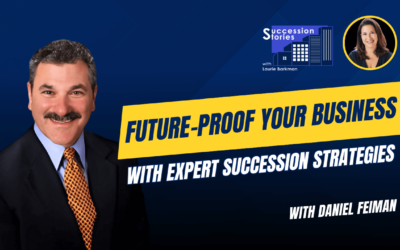Learn the secrets of putting profits first with Rocky Lalvani, The Profit Answer Man. Host Laurie Barkman talks with Rocky about how business owners can learn what’s actually happening in your business, so you know whether or not you’re profitable. With a Profit First Method you won’t have to wait till tax time to see the profitability picture.
Listen in to learn more about:
- Profitability as a primary goal
- Common accounting issues facing the majority of businesses
- How to track cash flow and profit throughout the year
- Implement five account tracking system
Show Links:
Don’t leave your exit to chance.
Stony Hill Advisors works with owners like you to get ready and maximize value when you’re ready to sell.
Visit www.stonyhilladvisors.com/podcast for a complimentary business valuation.
About Succession Stories Podcast
Succession Stories is hosted by Laurie Barkman, the Business Transition Sherpa– guiding business owners through the process from “transition to transaction.”
Learn more at https://thebusinesstransitionsherpa.com
Book a 1:1 Advisory call at:
We appreciate your support…subscribe, share, and post a review to share what you like about the show!
Transcript
Laurie Barkman:
Welcome to Succession Stories! I’m Laurie Barkman. As an exit value planning and M&A advisor, I call myself The Business Transition Sherpa. This podcast guides entrepreneurs from transition to transaction- from building value in your business to letting go.
What do I do when I’m not hosting a podcast? I work with owners to maximize business value with my firm, SmallDotBig. And as a Certified Mergers and Acquisitions Advisor with Stony Hill, I guide you through the complex process of selling your company.
Tune-in to Succession Stories for weekly insights to reward your hard work and avoid succession regrets. Hit subscribe wherever you listen to podcasts, and sign-up for our newsletter at successionstories.com. Here’s to your success!
Is this the year to sell your company? Don’t leave your exit to chance. Stony Hill Advisors works with entrepreneurs like you to get ready for what may be the biggest transaction of your life. Learn what your business is worth by visiting stonyhilladvisors.com/podcast.
Laurie Barkman:
Most business owners are focused on top line growth. But if you don’t focus on the bottom line, and what’s actually happening, you may find that you’re not profitable. It could take months or till tax time before you know, and that’s too long to wait. My guest Rocky Lalvani flips the script on how business owners typically think about accounting and budgets using the Profit First Method. Rocky serves as a fractional Chief Profit Officer for small businesses across the US. He also has a great podcast called Profit Answer Man, where I was recently a guest, and I encourage you to check it out! Enjoy today’s Succession Stories episode about the benefits of putting profits first with Rocky Lalvani.
Laurie Barkman:
Rocky Lalvani, thank you so much for joining me today on Succession Stories. It was an honor for me to be on your show, The Profit Answer Man, and that’s how we met. We had a fantastic conversation, and I thought this would be awesome, for this show to help educate our audience on various topics and this one is a favorite – profit. Who doesn’t want to talk about profit? It’s easier said than done. You work with so many clients that have gone from not a great situation to a much, much better situation and I look forward to hearing all about those challenges and wins with you today, so welcome.
Rocky Lalvani:
Thank you so much for having me, Laurie, excited to be here.
Laurie Barkman:
Let’s start by talking about the challenges. You get folks who are probably… they have – their books are a mess, or they don’t have books, accounting books, maybe they’ve been working with a bookkeeper, and maybe they haven’t. Regardless of that, they come to you and they say, “I want to do better, help me do better.” What do you see most commonly in terms of these challenges that entrepreneurs are facing with their business?
Rocky Lalvani:
This was a really big, “Aha!”, for me. I assumed that if you went into business, you understood the business of business, meaning the finances, because that’s really what it is and what I quickly learned, even before I got into this business, which is why I got into this business, was that most business owners loved what they did and accounting was at the bottom of the list for many business owners, varying in a variety of stages, you’ve got those business owners where everything is commingled with their personal life, they have no idea what’s coming and going, you’ve got people who’ve got relatively good bookkeeping and tax work being done, but nobody’s looking at it. Like when they get their tax return, it’s a short conversation of, “Congratulations, you’re profitable or unprofitable, and here’s how much you owe in taxes,” and the biggest thing business owners tell me is, “I don’t understand this. My accountant tells me I’m profitable and there’s no cash in the bank. My accountant tells me I lost a lot of money and my bank account is flush,” and I think there’s this very big disconnect between accounting and what profit is, and what cash in the bank is. Even for professionals like accountants and bookkeepers, and even for me, trying to watch all of that is really a struggle, and trying to figure it all out, because there’s so many factors that affect it, that don’t show up on the profit and loss statement and so nobody really has a good idea of what’s going on many times.
Laurie Barkman:
I see that, too. When I do valuations for business owners, I ask them for three years of tax returns, or their most recent P&L statements, depending where we are in an incomplete year and you’re right, that’s what we see. I look at the tax return and I’m like, “Okay,” but I have to unpack it, I have to look at all the expenses, and I have to flow it out and then I have to see what expenses are discretionary and it’s challenging for me to know, from the outside, it’s very challenging sometimes for the owners to know.
Rocky Lalvani:
Sure, the one thing you didn’t mention, and this is where I think we all get it wrong, people don’t look at the balance sheet, and they don’t look at the balance sheet month to month. This is where it becomes difficult because you have to lay out an entire year of balance sheets by month and then you’ve got to figure out the differential and this is not something that most accounting software does easily for you and most accountants don’t deliver this sort of a report to you. It’s those changes in the balance sheet that truly show your changes in net worth and you have to couple that with the profit and loss because each one is missing parts of the other and then sometimes you have to couple that with a cash flow report, but there’s no one easy place for you to get all the answers you want.
Then to your second point, yes. As business owners, let’s face it, we pay a lot of taxes, and there are discretionary business expenses and so being able to keep track of that and do that easily I think is important. The people who work with me also want to know that because they’re like, “Hey, if we get into a tough situation, I need to know what my true baseline business costs are, and then I need to know what my discretionary spending is,” and they want to see those differently, and for a lot of clients we’ll build out an ability to see that quickly and easily for them within their accounting system, so it’s setting up the right chart of accounts mumbo jumbo, so that you can quickly understand what’s going on in your business. Most accountants don’t set this up to make it easy for you to understand what’s going on. No fault of their own, they just do a standard chart of accounts.
Laurie Barkman:
I got my MBA, I learned the traditional methodologies, I’m a certified mergers and acquisitions advisor, again, learning some of the traditional ways that we look at the numbers and how to evaluate the effectiveness of the business so that we can assign a value based on different methodologies to help the owner understand what their business is worth today, but this discretionary account and these other ways to look at the business, what really get a true understanding of cash flow and profit can be tricky. There’s a book behind you if anyone’s watching on YouTube, and Rocky, I’ll hold it up here and also it’s called Profit First, and thank you very much for sending it to me, that was very nice of you. I appreciate that, when my guests on the show do that because it helps give me a perspective, a deeper perspective on why it’s important and why you’ve built a career around this. You are a prophet first professional and I’m guessing there’s a number of people in the audience including myself, honestly, I had not read this book yet, but I understand from you, it’s more popular in certain entrepreneurial circles, just like other books. Everybody who’s… I shouldn’t say everybody. It’s very common in certain entrepreneurial circles to read certain books, and this is one of them but it had missed my nightstand until now. Why don’t we talk about Profit First, so that in case people aren’t familiar with the methodology and the mindset, and how you and how you found it, and why you’ve integrated it into what you do, and how you help entrepreneurs?
Rocky Lalvani:
I found it through — I was doing a lot of financial coaching on the personal side, and helping people build wealth, it was always — I just could never understand it. We live in America, it’s a very abundant country, why aren’t there more millionaires? Like why is there such a struggle? I’m like, building wealth is not that difficult. It’s actually pretty simple, and through that journey, I came across this idea that business owners didn’t understand their finances, and somebody introduced me to the book from Mike. Mike’s a serial entrepreneur, like most entrepreneurs, he actually — this is kind of funny, because he owned a forensic accounting company. They actually investigated Enron, they’re the ones who said, “Hey, they were guilty.” He sells this company, along with some other companies, walks away with a seven figure payout, thinks he’s the smartest businessman in the world. Two years later, they’re coming for the keys to the house in the car. He lost it all and he made a lot of mistakes and he’s like, “How could I do this? How is this possible? How do I screw it up?” He had an, “Aha!” moment and one of the “Aha!” moments was that he’s been given the wrong equation. You’ve got an MBA, I’ve got an MBA, we’re told sales minus expenses equals profit but what does that make profit? A leftover, an afterthought, something at the bottom of the page, that after everything else is done, we get to know. Mike said, “Why don’t we just change the equation? Let’s make it sales minus profit equals expenses.” Now, this is a mindset shift. Basically, what it’s saying is, “Hey, we made this company, we started it to be profitable, we’re gonna take our profit first and we’re gonna constrain our expenses.”
Because too often we’re told, “You got to spend money to make money,” and that’s the thought of everyone who’s trying to sell you something and get your money. You don’t need to necessarily spend money to make money. You need to be… you don’t need more resources, you need to be more resourceful. Too often, and I think you probably see this all the time, for many business owners, they think profit is an event. When I sell my business, then I’ll get profit. When I hit this revenue number, then I’ll worry about profit. Okay, we’re all not Uber, we don’t have this unlimited blank check of money coming in that we can keep losing money. Profit needs to be a habit, that you start in the beginning and that you take up front. I mean, the purpose of business is to be profitable. This isn’t evil or greedy. It’s just the reality. If you’re not profitable, you can’t keep going. You can’t keep paying employees, you can’t keep your lights on and so you’ve got to change your mentality and change the way that you look at your finances.
Laurie Barkman:
You can’t keep borrowing if you can’t service the debt, and that’s when you’re talking about Michael, in his example, in his story where they came for the keys in the car, it’s because he had that as his collateral, right? They came for whatever they could in liquidation, and I do have conversations with people about growth and they they talk about growth as a challenge, because they feel like they’re holding themselves back on purpose, which is probably prudent in that sense of it isn’t all about growing the top line at any cost, right?
Rocky Lalvani:
As a matter of fact, I think the number one of the top causes of bankruptcy is growth, because nobody sat down at the beginning and figured out how much cash do I need to grow. If you don’t do that, you will find that your top line is growing phenomenally and your P&L might say you’re profitable but your ratios are going bad, the bankers are calling loans, and there’s no actual money because you borrowed so much that your debt service is killing you. If you don’t plan that out at the beginning, I think you will run into issues so growing just the top line without focusing on the bottom line, and cash flow is what gets a lot of people into trouble. We’ve done stories. I think the favorite is, everybody wants their product in Costco and people don’t realize if I’m going to put a product in Costco, especially today with COVID and supply chains, Costco gives me an order today, they don’t give me a check, right? They give me an order and now I’ve got to order my stuff. A lot of people who are out of China or wherever in the world, I’ve got to give them a deposit, then before they ship it to me, they want the rest of the money so now I am out all this money, the product arrives in my door, I do what I do with it, maybe I’m adding value or building onto it. That might take another 30 days. Now I ship it to Costco, so now we’re 120 days out, I still haven’t collected a penny from Costco and this is not Costco being evil. This is just the way business and retail is done. You can substitute that name for anybody. They start selling the product, and it’s going gangbusters so 60 days later, they say, “Hey, we want another order.” They barely paid you for the first order and you’re ordering again for the next round. Do you have all that cash? 90 days later, Costco sent you a check and that’s good but you’ve already got the next set of orders running and that’s that’s the problem you get in this cash trap. Once you sit down and you plan it out, you’ll see that it’s not as easy as you think and that you really need to know, maybe you can finance it. People do do that, but a lot of times, a lot of lenders will not allow you to finance it, they’ll finance real estate in your business, but they may not finance this whole process and Costco is really good about looking at the people they work with to make sure they’re not going to implode, so this is nothing about them being evil. They’re wonderful company I love.
Laurie Barkman:
Yeah, no, absolutely. It’s business and sometimes you can get cash upfront to fund your working capital. Let’s say if you’re in construction, there’s a deposit paid and that helps. It’s not 100% but at least it’s something so there’s always the cash outlay and the cash inflow you’re trying to balance. There was one chapter in the book, I thought was interesting, kind of funny, and the chapter was called ‘Your Business is an Out of Control Cash-Eating Monster’ that kind of speaks to what you’re talking about.
Let’s switch gears a little bit and talk about these foundational concepts you mentioned earlier, setting up different accounts, and if an accountant is listening, they’re probably sitting at the edge of their chair now thinking, “Oh, wait a minute, what’s going to happen?” Because you even said you’ll go in and set up a different chart of accounts. Are you talking about QuickBooks most likely? Or are there other systems that you’re using? What’s an accountant going to say when you come back and come back with all their wonderful advice? This is kind of a two part question, which is, what’s the advice, and then if a client is already working with an accountant, is their head gonna explode and go, “Oh, my God, what’s happening here?”
Rocky Lalvani:
Yes, maybe in a variety of ways. There’s two different things we need to talk about. There is a chart of accounts which most people don’t realize what it is and it’s just basically how your accountant maps all your spending, so that’s one thing. Fixing the chart of accounts is really not that difficult. They can move stuff around. More often than not, they will not fight me on that. They’re like, “Okay, I see what you’re doing, that makes sense, we can move this, it’s a couple clicks of a button.” They make it sound much more complicated than it is but it really isn’t.
The second thing that we talk about in the power of Profit First is bank accounts. Mike talks about opening up separate bank accounts, each with a specific purpose, and using them for that purpose. Here’s the dirty little secret. Most business owners are not opening up QuickBooks or whatever accounting software that they’re using, and looking at their reports and making business decisions. They’re getting on their phone, and they’re looking at their bank balance and they’re asking themselves one of two questions. Do I have money, and can I spend, or, do I have no money, and do I need to sell? This system is designed to leverage that bad behavior and turn it into a good positive behavior, because changing habits is hard and so what we do is we set up five accounts. The first one is the income account, all your money goes into the income account as you sell. Every week, you can look at your income account, you can see how much you’ve sold since the last time you did an allocation. It’s very easy now, I don’t have to look at my accounting software. My accounting software says I sold all this, but where is that money? Well, it’s in accounts receivable. It’s not Cash in Bank, so this is showing you cash in bank today. The next thing we do and we set up, there’s a chart in the book that shows you your target percentages, we start with where you are today and we allocate money from your income account. The first thing we allocate it for is profit because we said profit comes first. The next thing we allocate for is owner’s pay, because you, the owner, needs to get paid. If your household is a mess, because you’re not getting paid, you’re not going to show up at work excited, ready to hit the day with everything you’ve got and your spouse is probably screaming at you. Next stop the pesky government. They don’t take no for an answer so we need to make sure we set money aside for taxes and this is the most shocking thing you’ll hear from business owners who do this, because we all hate paying taxes, but they all look forward to tax time now, because they feel confident they can stroke a check for whatever that accountant says. They are no longer fearful, that anxiety is gone, and then the last account is your operating account. This is where you pay all your bills. Now, at this point, we’ve already covered our profit, we paid ourselves, we’ve covered taxes, now we truly know what is left to spend. Every business is different. Usually some businesses do this weekly, some do it twice a month, some do it once a month, they they just go into their income account, they have a set percentage, they allocate it to the other accounts and now when it’s time to spend, I go look at my operating account, and I see how much money is in it and I can then spend it. For those of you in the restaurant business, you will understand this, if you have a buffet, and you have small plates, people take less food, right? If you want to go on a diet, number one thing, get rid of the big plate, get a small plate, you take less, you eat less, you somehow are full, we’re doing the same thing with your money. We’re giving you less money to spend, and we’re telling you to figure out a way to be more resourceful. We don’t throw money at the problem. We think about it, and we figure out a better way. Essentially, we’re constraining your spending and we’re making sure you get paid, and you’re profitable, and your taxes get covered.
Now, accountants freak out at this because they’re like, “Oh, there’s all these accounts, there’s so much going on,” and I say to them very simply, “The reality is if we’re allocating twice a month, it’s an extra eight transactions.” If your bookkeeper or accountant is freaking out over eight transactions, you know what? You need to find a different one, because it’s not that difficult. The easiest way to talk to them is say, “Hey, don’t I have a sales tax account where you move my money out to cover sales tax, because it’s not my money and you want to make sure it’s there to pay sales tax that I owe the government?” It’s the exact same concept, except now we’re doing it for profit paying the rest of your taxes.
Laurie Barkman:
It’s such a different mind shift. I’m thinking about my college daughter. It’s the same idea, right, that I can’t give her everything. I have to allocate and teach her to allocate so that she doesn’t spend her savings account and so it’s a little bit different there. Let me ask you this. Let’s say there’s different indices and then you’re probably thinking, “Oh, this won’t work for me.” Let’s just try on for size a couple. Let’s say I am in construction, and I use subcontractors so I’ve got expenses, I’ve got to pay these laborers to help me build, let’s just say it’s residential housing, residential housing, I’ve got cash outlay for materials, does this methodology work for me or am I an off case?
Rocky Lalvani:
Nope. First of all, this methodology works for everyone. However, you have to customize it to you. Alright, so in this case, this is what we talk about real revenue and you’ll see that in the book. The simplest thing is, let’s say I’m a construction guy, I sell a project. I know that when I sell the project, 60% is my subcontractors, right, and I need to pay them and I need to pay them upfront, because if I don’t pay them, they don’t show up so I go out, and I sell a job and I collect money. I know that 60% of that money is subcontractors. I take that out before I do anything else so it doesn’t even hit my allocations, my subcontractors get pulled out upfront, into a separate account where I pay my subcontractors from.
Now, a lot of times in construction, what I will see done is they do a 50-40-10, so they get 50% on the beginning, they get 40% when they hit milestones, and they get 10% when the job is done. What we do a lot of times for them to make it easy, is when they get the first 50% payment, it immediately goes into the subcontractor materials account so it doesn’t even hit their income account, goes straight to subcontractors and materials. I know up front, I have the money to pay my subcontractors and material for this job. The 40% goes through the rest of this system. With the exception of profit, the 10% that comes in on the last payment immediately goes to the profit account so we know we’re going to be 10% profitable and when we get that final check, which pushes you to get the work done and get your final check we just put the 10% in the profit account. It makes life simple for everybody and you’re guaranteed your 10% profit.
Laurie Barkman:
Which for construction is actually a pretty good number. If they can do 10% profit, I think they’d be ecstatic. That’s for some sectors, maybe even 30% higher than the benchmark so wouldn’t that be fantastic?
Rocky Lalvani:
It will and here’s the thing, let’s just say that they’ve got a 7% margin. Well, they know when they get the last check 70% goes to profit 30% goes into whatever their system is. That’s where you got to tweak it and customize it to make it easy and work for you. I’m going to tell you in the beginning, you’re going to be full of hiccups, you’re going to be full of problems, you’re going to be moving money around, you’re going to be freaking out but over a cycle, and a cycle could be 3, 6, 12 months, you’ll start to get better and better and then over a couple of years, you’re going to hit the targets that Mike has in the book. This is not an overnight success story. If we have to change the way we do business or add equipment or get rid of equipment, I can’t get out of an equipment lease tomorrow, it might take me two years to get out of a lease, it might take me two years to make changes, and that’s okay, you’re moving in the right direction.
Laurie Barkman:
I have some clients that are afraid of growth, they don’t think they can afford it. One client has grown revenues year over year, even with COVID. They’ve grown, let’s say 20% year over year, which is pretty substantial, but their profits have not kept pace at that same percentage, so they’re driving more top line, they’re not driving more bottom line. That’s I’m guessing a pretty common problem, and so I’m thinking about scenarios, like if someone’s listening, and they’re thinking, “Yeah, that’s me,” and, “Alright, so if I’m going to change my methodology of how I’m looking at my bank accounts,” and there’s a training component here, there’s a process component, and then there’s a service component because that they might need a service provider like yourself, or I guess perhaps could try to do it themselves. I’m guessing it might be tricky and that change is hard. No one really likes change. we force ourselves to do it. If I was going to talk to a client and say, “Look, I really think this would help you”, what are some of those extreme pain points that you’d say this type of scenario really lends itself to? For example, let’s say I’m not ready to sell my business right now but I want to get ready within the next three to five years. Is it too late for me to change my ways? Or am I good in thinking about this change now so that I can get my books and maximize my profits so that my evaluation, when it’s time to get my multiple, looks the best it can be?
Rocky Lalvani:
It’s never too late to change. This does take time. And I think that’s the biggest thing. Business owners that want to sell in three to five years, need to start fixing things today so that when you look back two or three years at financials, you’ve got a good solid history, because that’s what makes you more valuable. I always tell people a joke. The heaviest weight at my gym is the front door. Seems people have a struggle opening.
Laurie Barkman:
That’s a good one. I like that.
Rocky Lalvani:
It’s the same thing. Mike goes on stage, people come up to him, he’s got all these fanboys and fangirls all, “I love Profit First.” His first question is, “Did you open the accounts?” “Well, no, I haven’t gotten to it.”, so literally, the hardest step is opening the bank accounts. For whatever reason, business owners and opening bank accounts is like oil and water, they just don’t mix. I’ll make it simple. For everybody listening, I just want you to open one bank account, we’re going to call that bank account profit and every month, you’re just going to take 1% of last month’s sales, and you’re going to put it in the profit account and you’re going to do this for one quarter. Then you’re going to look at your profit account and go, “Hmm, look at that, I’ve got some money. I didn’t miss it, I survived,” and then you’re going to take the 1% and change it to 2% and so if you need to slowly move into this, that’s your plan. For the rest of you, let’s just rip the band aid off and let’s roll.
Laurie Barkman:
Rocky, if people want to learn more about how you help them change their ways, become more profitable, get a new math equation, and get some new bank accounts, how can they find you? What’s a great way to get in touch?
Rocky Lalvani:
Before they come looking for me, can I ask you all to do one thing? Really great favor. Laurie has been sharing tremendous information with you. She constantly does it. You don’t even pay for this. There’s a simple way to pay for it. Like it, share it, say thank you, for her and for this show. Whatever you’re listening on, there’s got to be some way for you to show gratitude.
As for me, if you’d like to come find me, I teach everything for free, so Profit Answer Man podcast. We actually go through the entire book, I don’t read it to you, I just tell you all the highlights of the book. We’ve got people who’ve come on who’ve used the system and they tell their stories. I have my competition, other Profit First professionals come on, they talk about how they’ve used the system, how they serve their clients and then we’ve got business owners that come on, and they talk about how you can be more profitable, so tons of free knowledge, everything. You can implement this yourself if you want to. Some people go, “This gives me a headache, would you just please do it for me?” In that case, reach out.
Laurie Barkman:
That’s fantastic, and thanks Rocky, for suggesting the share. I appreciate my audience so much and of course love it when they do share our content and like it and share their feedback and questions with us. It is meaningful to know the feedback, but also to know what trips them up and what gives pause. That’s really great. I appreciate that very much. Is there anything that I missed today in our conversation that you’d like to add or share?
Rocky Lalvani:
No, I think the biggest thing is, if you just want to ease into this, just go open one bank account, put the 1% away, and just keep doing it and you’ll start to see how big of a difference it makes over time.
Laurie Barkman:
It’s going to make a big difference. Thanks so much Rocky for being with me on Succession Stories, and I look forward to continuing the conversation with you.
Rocky Lalvani:
Thanks for having me.
Laurie Barkman:
Listeners, thank you so much for tuning in. You can always catch Succession Stories on any of your favorite podcast players or YouTube. Don’t forget to like and subscribe to the show! If you want to maximize the value of your business and plan for future transition, reach out to me for a complimentary assessment at meetlauriebarkman.com. Tune in next week for more insights from transition to transaction. Until then…here’s to your success.
My objective is for you to have a lucrative and successful succession. If you want to understand the value of your company today, the potential net proceeds of a transaction, and your financial needs after you leave the business, that’s a great place to start. The sooner you understand these numbers, the more time you’ll have to close the gap, if there is one. Take the next step by requesting an initial meeting to begin planning for your business transition and strategic exit today. Request a call with me at meetlauriebarkman.com.

